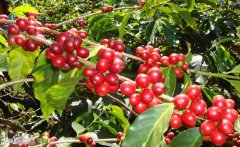The source of coffee beans the source of Hawaiian coffee beans the open source of Kona coffee
Source
Editing
Start
In 1813, a Spaniard first grew coffee in the ManoaValley Valley of Oahu, which is today the main campus of the University of Hawaii. In 1825, an English agronomist named John Wilkinson transplanted some coffee from Brazil to grow in the coffee garden of Chief Birch on the island of Oahu. Three years later, an American missionary named Samuel Riveland Rags brought the branches of the coffee tree from Birch Emirates Garden to Kona, a descendant of the Arabica coffee tree that first grew on the Ethiopian plateau. To this day, Kona Coffee still carries on its noble and ancient lineage.
Develop
The earliest coffee cultivation in Hawaii had adopted the model of large-scale coffee plantations, and at that time, coffee had not yet become a widely grown crop in the world, and the production and sale of Kona coffee had experienced several ups and downs. After the outbreak of World War I, the demand for coffee increased sharply, and the government bought a lot of coffee for soldiers in order to maintain their combat ability. the rise in demand led to a rise in prices, and Kona coffee was no exception. The period from the outbreak of World War I to 1928 was the golden age of Kona Coffee. But the Great Depression that followed dealt a heavy blow to Kona Coffee. In 1940, the second World War caused the price of coffee to rise again. In order to avoid excessive price increases, the US government set a price cap for coffee. Even so, coffee farmers in Hawaii got a lot of benefits. During this period, their means of transportation for transporting coffee fruits were all replaced by donkeys and jeeps.
Establish a position
In the 1970s and 1980s, the price of Kona Coffee experienced several ups and downs, but it was from this period that Kona Coffee established itself as the top coffee in the world. Even though Kona Coffee has been famous all over the world, its production remains relatively low.
Kona coffee has been grown in Kona since the early 19th century, and it has never been interrupted, and only the coffee produced here can be called "Hawaiian Kona". The raw beans of Hawaiian Kona Coffee are usually 100 packages of individual coffee beans. Kona coffee beans are also often used to make mixed coffee along with coffee beans from other parts of the world. Kona coffee beans mixed with other beans are marked with "Kona mixed beans (KonaBlend)" on the package. unfortunately, the content of Kona beans in these mixed beans may be very low, and the minimum content of Kona beans in Hawaii that can use the "Kona" label is only 10%. Therefore, if you are not in Kona in Hawaii, it is difficult to have 100% pure Kona coffee beans.
Flavor
Editing
Smooth, fragrant, with attractive nutty aromas
Baking method
Editing
Light to moderate baking
Important Notice :
前街咖啡 FrontStreet Coffee has moved to new addredd:
FrontStreet Coffee Address: 315,Donghua East Road,GuangZhou
Tel:020 38364473
- Prev

The characteristics of Hawaiian travel coffee beans how to taste Hawaiian coffee
The smell of Hawaii is in Hawaii, you can watch the fiery sunset sink into the red-orange sea, feel the fresh air filled with the scent of flowers, and sit by the sea and drink a cup of Kona coffee. I'm afraid there is no place in the world that can offer you such enjoyment. The earliest settlers in Hawaii arrived here between 300 and 400 AD, and historians speculated that he
- Next

African Coffee Bean Producing Area Coffee Kenya
Kenya coffee is mostly grown at altitudes of 1500- 2100 meters and harvested twice a year. Its main characteristic is the distinct fruit fragrance, the common fruit fragrance is citrus. Kenya coffee has a multi-layered taste and juice acidity, perfect grapefruit and wine flavors, moderate body, and is a favorite of many coffee industry insiders. Kenya Coffee Borrow
Related
- Does Rose Summer choose Blue, Green or Red? Detailed explanation of Rose Summer Coffee plots and Classification in Panamanian Jade Manor
- What is the difference between the origin, producing area, processing plant, cooperative and manor of coffee beans?
- How fine does the espresso powder fit? how to grind the espresso?
- Sca coffee roasting degree color card coffee roasting degree 8 roasting color values what do you mean?
- The practice of lattes: how to make lattes at home
- Introduction to Indonesian Fine Coffee beans-- Java Coffee producing area of Indonesian Arabica Coffee
- How much will the flavor of light and medium roasted rose summer be expressed? What baking level is rose summer suitable for?
- Introduction to the characteristics of washing, sun-drying or wet-planing coffee commonly used in Mantenin, Indonesia
- Price characteristics of Arabica Coffee Bean Starbucks introduction to Manning Coffee Bean Taste producing area Variety Manor
- What is the authentic Yega flavor? What are the flavor characteristics of the really excellent Yejasuffi coffee beans?

